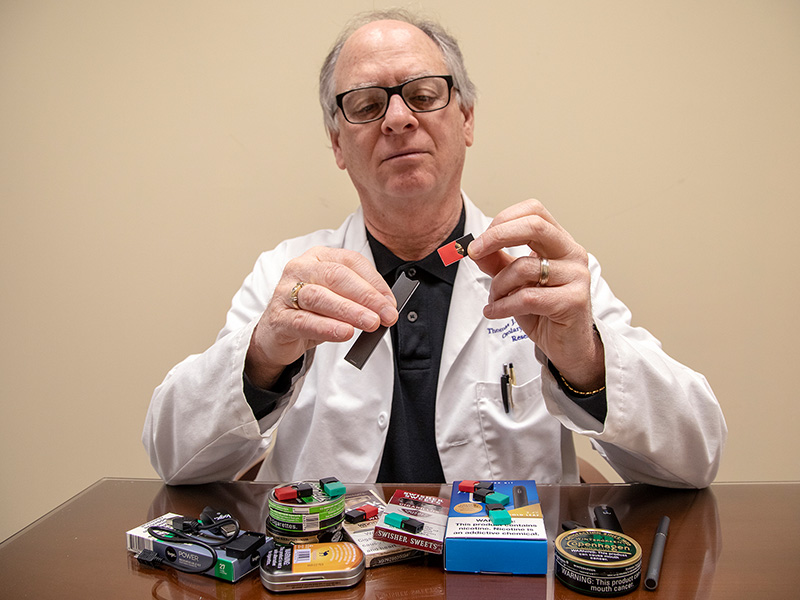What do we know about vaping? Not enough.

If you have somehow managed to avoid news related to electronic cigarettes and vaping for the past month, your run of good fortune has ended.
The Centers for Disease Control and Prevention reported 530 cases of e-cigarette related lung-illness hospitalizations nationwide with seven deaths. At least three states have limited their sale and the White House is looking for ways to ban the products.
So beside this flurry of news, what do we actually know about the health risks posed by e-cigarettes? Nowhere near enough, says Dr. Thomas Payne of the University of Mississippi Medical Center.
“We are still missing important evidence,” said Payne, professor of otolaryngology and communicative sciences and director the ACT Center for Tobacco Treatment, Education and Research.
By nature of their design, “The use of all current electronic cigarettes appear to be associated with significant health risks,” Payne said. That’s because e-cigarettes work by heating liquids that serve as a vehicle to deliver nicotine and flavors to the user. These compounds, typically propylene glycol and glycerol, are FDA-approved.
“However, once you heat these compounds, they change, and those byproducts are not FDA approved for human consumption,” Payne said. “They produce volatile organic compounds including various aldehydes like formaldehyde and acrolein, which we know from other research increase the risk for cardiovascular disease and certain cancers.
“Damage can directly to our lungs, as well as other organs,” Payne said.
Dr. John Spurzem, professor of medicine and division chief for pulmonology, also notes that many of the vaping-related illnesses involve e-liquids containing vitamin E oil.

“Inhaling any oil is a bad idea. It’s very toxic and can cause acute lung injuries or lipoid pneumonia as a result of oil getting in the lungs,” Spurzem said.
Furthermore, there are about 7,000 unique flavors of e-liquid on the market, each with their own unique chemical composition.
“And when you heat these flavors, their chemistry changes as well,” Payne said. “I doubt scientists have studied more than 30 of them at this point.”
Until 2016, the Food and Drug Administration had no regulatory authority over the components of electronic cigarettes and related devices, and products introduced to the market prior to then are not subject to the same regulations.
Payne and other researchers at UMMC are part of the American Heart Association Tobacco Research and Addiction Center, or A-TRAC. Refunded by the National Institutes of Health and the Food and Drug Administration in 2018, the group is studying the perceptions and attitudes surrounding vaping, the chemicals in vaping products and the cardiovascular disease risks they pose.
Other groups are studying CVD risk as well. Some of the “most damning evidence” against e-cigarette use to date, Payne said, comes from a University of California San Francisco study of 70,000 people. Researchers there showed that daily e-cigarette use was associated with a doubled risk of heart attack compared to non-users. People who used both traditional and e-cigarettes saw their risk increase five-fold.
“If we understand the effects of these devices and their use, we can begin to curtail their use through changes in regulatory policy,” Payne said.
Some states are already setting policy. Michigan, New York and Massachusetts have limited sales of e-cigarettes products in various ways in the past month.
“This should be a federal law,” Payne said in regards to Michigan’s decision to ban the sale of flavored vaping products. “In 2010, the United States passed a law banning flavored cigarettes, except for menthol. This contributed to the youth cigarette smoking prevalence.”

Payne thinks the introduction of flavored vaping products could get a new generation addicted to nicotine. The New England Journal of Medicine reports that about 1 in 9 12th-graders vape near daily. A quarter have vaped in the past month, a proportion that has more than doubled since 2017.
While young people prefer to vape sweet flavors, while adults tend to go for unflavored, menthol, or tobacco-flavored e-liquids. Adult use of electronic cigarettes often centers on an effort to quit traditional smoking, but there is limited evidence that this actually works.
“The data show that using e-cigarettes is about as successful as a cold-turkey approach,” Payne said, citing both clinical trials and observational studies of smoking cessation using the products. “The most successful interventions include working with a trained counselor and the use of an approved pharmacotherapy,” Payne said, such as nicotine patches and gums, or Zyban and Chantix, two prescription drugs on the market indicated for smoking cessation.
Spurzem also discourages the use of e-cigarettes as a quitting tool, but warns especially against using bootleg vaping products.
“Do not buy these products off the street, because you have no idea what they contain,” he said.
As of Sept. 26, the Mississippi State Department of Health has reported three cases of vaping-related lung illness and one death statewide, all in young adults.

“This is a very serious concern, and one that is unfolding every day,” said MSDH State Epidemiologist Dr. Paul Byers in a press release. “While we know that many of the cases in the US report vaping cannabis products, such as tetrahydrocannabinol (THC), some have reported only vaping nicotine products.”
There is still a lot that we don’t know about what is making these people sick. No specific product such as the device, liquid, refill pods or cartridge has been clearly identified as the cause,” Byers said.
“The key takeaway here is that there is nothing to suggest that electronic cigarette use has any substantial benefit, and the vast majority of evidence we do have so far suggests that there are significant risks associated with electronic cigarettes,” Payne said.
“Based on what we know so far, they really need to go away.”


